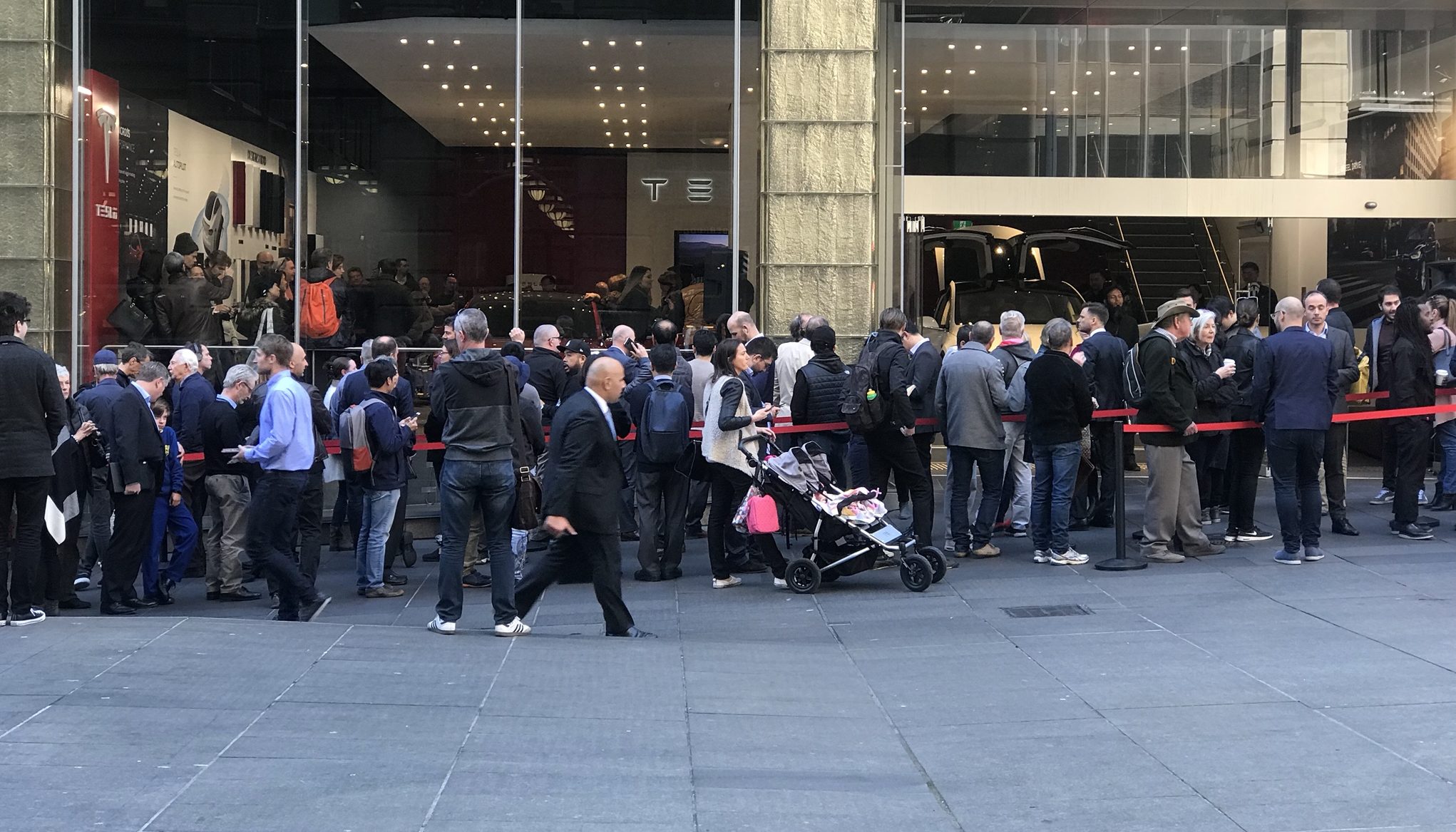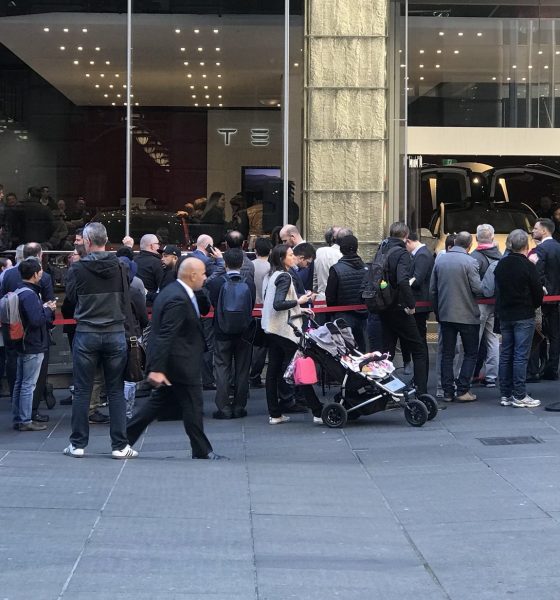

Investor's Corner
Tesla extends $1.1B warehouse loan agreements amid signs of strong Model 3 demand
A Form 8-K recently filed by Tesla to the United States Securities and Exchange Commission has revealed that the company extended its $1.1 billion warehouse loan agreements with Deutsche Bank AG for another year. The revised terms outlined in Tesla’s Form 8-K state that the agreements’ borrowing availability has been extended from August 17, 2018, to August 16, 2019. The maturity date of the agreement was also extended from September 2019 to September 2020.
Following is the text of Tesla’s recent Form 8-K submitted to the SEC.
Extension of Vehicle Lease Warehouse Agreements
On August 16, 2018, certain subsidiaries of Tesla, Inc. (“Tesla”) that are respectively parties to (i) an Amended and Restated Loan and Security Agreement (the “A&R 2016 Warehouse Agreement”) and (ii) a Loan and Security Agreement (the “2017 Warehouse Agreement,” and together with the A&R 2016 Warehouse Agreement, the “Warehouse Agreements”), each dated August 17, 2017, with Deutsche Bank AG, New York Branch as administrative agent and the other parties named therein, entered into an amendment to each of the Warehouse Agreements (together, the “Amendments”).
Among other changes, the Amendments extended the borrowing availability date under the Warehouse Agreements from August 17, 2018, to August 16, 2019, and extended the maturity date of the Warehouse Agreements from September 2019 to September 2020. The aggregate lender commitment, which is shared between the Warehouse Agreements, remains unchanged at $1.1 billion.
Warehouse loan agreements are utilized as tools to help finance inventory. Last October, Tesla raised the credit line at the German bank by $500 million to $1.1 billion, and during that time, the California-based electric car maker noted that it was planning an expansion of its in-house leasing program. That said, even with the recent extension of the warehouse agreement, the aggregate lender commitment of $1.1 billion remains unchanged.
Tesla’s recent 8-K Form could be accessed in full here.
Tesla’s recent 8-K filing comes as the demand for the Model 3 sedan showed encouraging signs after the vehicle was previewed in Australia for the first time. After sustaining the Model 3’s 5,000/week production rate during multiple weeks in July, Tesla announced earlier this month that it is bringing the electric car to Australia and New Zealand. Reservation holders residing in the two countries received invitations for viewings of the vehicle at Tesla’s stores in Sydney, Melbourne, Brisbane, and Auckland.
The Model 3’s viewings in Australia proved to be successful. Posts uploaded of the event on Twitter revealed lines of people lining up to get a hands-on experience with the electric car. One of the Model 3 reservation holders, Andreas Stephens of Sydney, even noted in a statement to Drive that the electric car would be his first vehicle in 25 years.
“I’m not a car enthusiast as such; I never had a need to upgrade my car. When I bought my first car my dream was to have an electric car as my next car. But at the time, in the early 1990s, that seemed like a pretty unrealistic expectation. So I’m really excited that I’m now actually able to get an electric car. It’s fantastic, more than anything I’ve experienced in a car,” he said.
Queue at Tesla Martin Place to see Tesla Model 3 pic.twitter.com/UbEJ9KC1dc
— Heath Walker (@TexWalkerRanger) August 21, 2018
In the United States, Model 3 production appears to be hitting its stride. Apart from recently passing the 100,000-vehicle mark in its VIN registrations for the electric car, Tesla also appears to ba pacing towards an improved pace for the vehicle’s production. This was highlighted by George Galliers of Evercore ISI after an extensive tour of the Fremont factory, who noted that Tesla could hit as much as 8,000 Model 3 per week with very little capital expenditure.
“Tesla seems well on the way to achieving a steady weekly production rate of 5,000 to 6,000 units per week. We are incrementally positive on Tesla following our visit. We have confidence in their production. We did not see anything to suggest that Model 3 cannot reach 6k units per week and 7k to 8k with very little incremental capital expenditure. Focusing on the fundamentals and setting aside talk of privatization, we are incrementally positive on Tesla following our visit,” the analyst noted.

Investor's Corner
Tesla stock closes at all-time high on heels of Robotaxi progress

Tesla stock (NASDAQ: TSLA) closed at an all-time high on Tuesday, jumping over 3 percent during the day and finishing at $489.88.
The price beats the previous record close, which was $479.86.
Shares have had a crazy year, dipping more than 40 percent from the start of the year. The stock then started to recover once again around late April, when its price started to climb back up from the low $200 level.
This week, Tesla started to climb toward its highest levels ever, as it was revealed on Sunday that the company was testing driverless Robotaxis in Austin. The spike in value pushed the company’s valuation to $1.63 trillion.
Tesla Robotaxi goes driverless as Musk confirms Safety Monitor removal testing
It is the seventh-most valuable company on the market currently, trailing Nvidia, Apple, Alphabet (Google), Microsoft, Amazon, and Meta.
Shares closed up $14.57 today, up over 3 percent.
The stock has gone through a lot this year, as previously mentioned. Shares tumbled in Q1 due to CEO Elon Musk’s involvement with the Department of Government Efficiency (DOGE), which pulled his attention away from his companies and left a major overhang on their valuations.
However, things started to rebound halfway through the year, and as the government started to phase out the $7,500 tax credit, demand spiked as consumers tried to take advantage of it.
Q3 deliveries were the highest in company history, and Tesla responded to the loss of the tax credit with the launch of the Model 3 and Model Y Standard.
Additionally, analysts have announced high expectations this week for the company on Wall Street as Robotaxi continues to be the focus. With autonomy within Tesla’s sights, things are moving in the direction of Robotaxi being a major catalyst for growth on the Street in the coming year.
Elon Musk
Tesla needs to come through on this one Robotaxi metric, analyst says
“We think the key focus from here will be how fast Tesla can scale driverless operations (including if Tesla’s approach to software/hardware allows it to scale significantly faster than competitors, as the company has argued), and on profitability.”

Tesla needs to come through on this one Robotaxi metric, Mark Delaney of Goldman Sachs says.
Tesla is in the process of rolling out its Robotaxi platform to areas outside of Austin and the California Bay Area. It has plans to launch in five additional cities, including Houston, Dallas, Miami, Las Vegas, and Phoenix.
However, the company’s expansion is not what the focus needs to be, according to Delaney. It’s the speed of deployment.
The analyst said:
“We think the key focus from here will be how fast Tesla can scale driverless operations (including if Tesla’s approach to software/hardware allows it to scale significantly faster than competitors, as the company has argued), and on profitability.”
Profitability will come as the Robotaxi fleet expands. Making that money will be dependent on when Tesla can initiate rides in more areas, giving more customers access to the program.
There are some additional things that the company needs to make happen ahead of the major Robotaxi expansion, one of those things is launching driverless rides in Austin, the first city in which it launched the program.
This week, Tesla started testing driverless Robotaxi rides in Austin, as two different Model Y units were spotted with no occupants, a huge step in the company’s plans for the ride-sharing platform.
Tesla Robotaxi goes driverless as Musk confirms Safety Monitor removal testing
CEO Elon Musk has been hoping to remove Safety Monitors from Robotaxis in Austin for several months, first mentioning the plan to have them out by the end of 2025 in September. He confirmed on Sunday that Tesla had officially removed vehicle occupants and started testing truly unsupervised rides.
Although Safety Monitors in Austin have been sitting in the passenger’s seat, they have still had the ability to override things in case of an emergency. After all, the ultimate goal was safety and avoiding any accidents or injuries.
Goldman Sachs reiterated its ‘Neutral’ rating and its $400 price target. Delaney said, “Tesla is making progress with its autonomous technology,” and recent developments make it evident that this is true.
Investor's Corner
Tesla gets bold Robotaxi prediction from Wall Street firm
Last week, Andrew Percoco took over Tesla analysis for Morgan Stanley from Adam Jonas, who covered the stock for years. Percoco seems to be less optimistic and bullish on Tesla shares, while still being fair and balanced in his analysis.

Tesla (NASDAQ: TSLA) received a bold Robotaxi prediction from Morgan Stanley, which anticipates a dramatic increase in the size of the company’s autonomous ride-hailing suite in the coming years.
Last week, Andrew Percoco took over Tesla analysis for Morgan Stanley from Adam Jonas, who covered the stock for years. Percoco seems to be less optimistic and bullish on Tesla shares, while still being fair and balanced in his analysis.
Percoco dug into the Robotaxi fleet and its expansion in the coming years in his latest note, released on Tuesday. The firm expects Tesla to increase the Robotaxi fleet size to 1,000 vehicles in 2026. However, that’s small-scale compared to what they expect from Tesla in a decade.
Tesla expands Robotaxi app access once again, this time on a global scale
By 2035, Morgan Stanley believes there will be one million Robotaxis on the road across multiple cities, a major jump and a considerable fleet size. We assume this means the fleet of vehicles Tesla will operate internally, and not including passenger-owned vehicles that could be added through software updates.
He also listed three specific catalysts that investors should pay attention to, as these will represent the company being on track to achieve its Robotaxi dreams:
- Opening Robotaxi to the public without a Safety Monitor. Timing is unclear, but it appears that Tesla is getting closer by the day.
- Improvement in safety metrics without the Safety Monitor. Tesla’s ability to improve its safety metrics as it scales miles driven without the Safety Monitor is imperative as it looks to scale in new states and cities in 2026.
- Cybercab start of production, targeted for April 2026. Tesla’s Cybercab is a purpose-built vehicle (no steering wheel or pedals, only two seats) that is expected to be produced through its state-of-the-art unboxed manufacturing process, offering further cost reductions and thus accelerating adoption over time.
Robotaxi stands to be one of Tesla’s most significant revenue contributors, especially as the company plans to continue expanding its ride-hailing service across the world in the coming years.
Its current deployment strategy is controlled and conservative to avoid any drastic and potentially program-ruining incidents.
So far, the program, which is active in Austin and the California Bay Area, has been widely successful.








